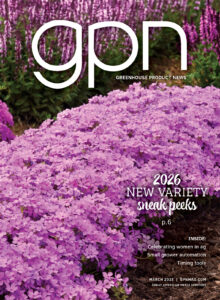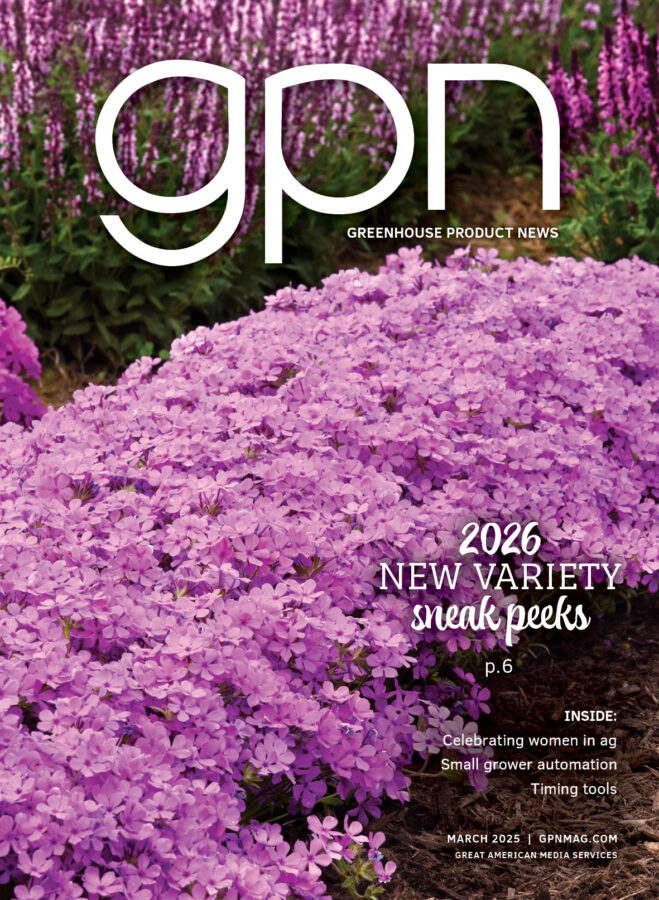Producing Vegetative Petunias and Calibrachoa
Two stars of the booming vegetatively propagated beddingplant market are petunias and calibrachoa. These closely related species offerconsumers rapid growth, a wide range of colors and durability. The vigor ofpetunias and calibrachoa, while great for consumers, presents a challenge togrowers — too much of a good thing can make for tangled plants and shipping problems. In the following article we will discuss how to cost-effectively grow petunias and calibrachoas with an emphasis on the areas we have been researching: propagation and growth (vine) control.
Cultivars
Most vegetatively propagated petunias are hybrids betweenthe bedding petunia (Petunia x hybrida) and Petunia axillaris. Of course, theoriginal seed-propagated bedding petunia is a hybrid between P. axillaris andP. intergrifolia. However, the reintroduction of P. axillaris genetics broughta greater emphasis on vigorous, trailing growth and postproduction durability.The first of the new cultivars were released in the early 1990s with the introductions of 'Supertunias'. Supertunias are vegetatively propagated because this group produces few if any seed. The seed-propagated 'Wave' series was also introduced and has similar characteristics, but a more restricted color range. Since then several series of great vegetativelypropagated petunias have been released, expanding the range of growth habits,colors and degrees of doubleness offered.
The calibrachoa (Calibrachoa hybrids) is considered a newspecies in the floriculture trade, but actually has been in cultivation sincethe early 19th Century. A renewed focus on the Calibrachoa genus has resultedin the introduction of several new cultivar series in the last few years.Calibrachoa have a more limited color range than petunias but finer-texturedfoliage, a more pronounced trailing habit and abundant, small, single flowers.
Propagation
Our research goal was to develop high-quality, highlybranched, compact vegetatively propagated petunia and calibrachoa plugs. Anumber of factors were examined that influence flowering and branching,including photoperiod, plug flat density, Florel application, light intensity,light quality and fertilizer rate. Petunia cultivars examined included'Cascadia Charme', 'Cascadia Improved Charlie','Petitunia Bright Dream', 'Doubloon Blue Star','Marco Polo Odyssey' and 'Pocket Petunia'; calibrachoastested included 'Liricashower Rose' and 'ColorburstViolet'.
HID lighting improved rooting during low-light times of theyear, especially for slow-rooting cultivars such as Cascadia Charme, and willreduce time to transplanting by 7-10 days. Without HID lighting, cultivars thatnormally root rapidly will be ready to transplant in 10-14 days; slow-rootingcultivars will be ready to transplant in 17-24 days. Plugs grown under HIDlighting and short days were the shortest. Light quality from either metalhalide or high-pressure sodium lighting apparently had little effect,indicating that both types of lights are acceptable. Ambient lighting and longdays increased plug height and final plant height for some cultivars. Long-dayphotoperiods increased plug height and final plant height for some cultivarsand decreased final plant diameter for all cultivars. High-density (288) flatsincreased the percentage of cuttings lost to bacterial diseases and delayedflowering by an average of 2-4 days for all cultivars compared to low-density(105) flats.
Cuttings should be rooted at 70¡ F minimum temperaturewith bottom heat. Use propagation tents and avoid overmisting, which slowsrooting and increases the likelihood of Botrytis and bacterial diseases. Somepropagators recommend using rooting hormones with 2,500 IBA, especially onslow-to-root cultivars such as Cascadia Charme.
Flowering Control
Typical seed-propagated petunias are facultative long-dayplants. Flowering will occur under LD or SD; however, plants will flowerearlier with longer photoperiods and higher light intensities. Most vegetativepetunias are also facultative long-day plants; however, a few cultivars act asshort-day or day-neutral plants. Apparently, high light intensity can overcomephotoperiodism, as some cultivars are long-day plants under ambient light, butare day-neutral under HID lighting. All calibrachoa cultivars tested to datehave been facultative long-day plants.
What does this mean for the grower? Long-day lighting shouldbe given to both plugs during propagation and finished plants during theshort-day time of the year, from October to March, to decrease time toflowering. Long-day lighting applied only during propagation may decrease croptime for photoperiod-responsive cultivars, such as Petitunia Bright Dream, byup to two weeks. Generally, however, long-day lighting during propagation willdecrease crop time by a week or less.
Production
Temperature. Grow at60-65¡ F night temperature until rooted cuttings or plugs are establishedin the final container. Continue growing petunias at 60-65¡ F nights and60-75¡ F days for most rapid growth; lower temperatures of 55-60¡ F canbe used, but will slow growth. Calibrachoa can be grown at a wider temperaturerange from 50¡ F night to 85¡ F day.
Light. Grow plantsunder a minimum of 5,000-6,000 footcandles. HID lighting of 500 footcandles ormore improves rooting during low-light periods, especially for slow-to-rootcultivars. HID lighting can also increase the number of branches, but only forplants grown under long days.
Irrigation. Whilepetunias and calibrachoas are drought-tolerant in the landscape, keep plantsmoist during production for optimum growth.
Nutrition. Bothpetunia and calibrachoa are considered to be relatively heavy feeders withrecommended rates from suppliers of 250-350 ppm nitrogen for petunia and200-300 ppm nitrogen for calibrachoa. However, we found that 150 ppm nitrogenwas sufficient for good growth; higher fertilizer rates either had no effect ordelayed flowering. Not surprisingly, however, foliage color was darker greenfor plants irrigated with 300 ppm nitrogen (bottom right). If lower fertilizerrates near 150 ppm nitrogen are used, plants can be greened up by using higherrates for a couple of weeks just prior to shipping. Phosphorus rates should be1/4-1/3 of nitrogen and potassium rates should be 2/3 of nitrogen. Calibrachoaand petunias have a high requirement for iron; be sure to incorporateadditional iron into the nutritional program. Iron chelates can be used assprays or drenches.
Growing Media.Petunia and calibrachoa are adaptable plants that thrive in a variety ofcommercial growing media. pH should be monitored and maintained at 5.5-6.0.Calibrachoa prefer low pH and can readily tolerate pHs lower than 5.5.
Growth Control
Both petunia and calibrachoa grow rapidly and can becomeleggy. Environmental manipulation is the first control strategy to consider.Grow plants under high light, cool temperatures and zero to negative DIF toreduce stretch and promote rapid flowering. Pinching and pruning can also beused as needed to control growth (see Pinching section for details).
Many vegetative petunia cultivars are particularly vigorousand plant growth regulator (PGR) applications may be required. The generalcultural information provided by the propagators list Bonzi and Sumagic aspossible PGRs to apply, although no specific rates were provided. Dr. TerriStarman of Texas A&M University recommends Sumagic foliar sprays of 20 ppmin the "Tips on Regulating Growth of Floriculture Crops" guide.Researchers at Michigan State University conducted a number of PGR studies onvegetatively propagated plants. For vegetative petunias, they used A-Rest andSumagic on 6-week-old plugs, while Bonzi, B-Nine and Cycocel were not used.They recommended a single spray application of A-Rest at 100 ppm or two sprayapplications of Sumagic, with the first at 20 ppm, followed by a single application two weeks later at 10 ppm. Please note that their recommended rates were based on a higher spray volume (1 gallon of spray applied over 150 sq. ft.) than the typical volume (1 gallon of spray applied over 200 sq. ft.) listed on most PGR labels.
Research at North Carolina State University alsoinvestigated the use of a wide range of PGR rates on the growth of CascadiaImproved Charlie vegetative petunia. The PGRs used included: A-Rest (60, 80,100, 120 or 140 ppm), Bonzi (40, 60, 80, 100 or 120 ppm), Sumagic (5, 10, 20,30 or 40 ppm) and a tank mix using a single rate of B-Nine (2,500 ppm) plusincreasing rates of Bonzi (40, 60, 80, 100 or 120 ppm). The PGRs were applied 2weeks after transplanting the cuttings into 6-inch pots. Flowering was notdelayed by any of the PGR applications, with most plants flowering 71 daysafter transplanting.
A-Rest at spray rates less than 80 ppm were effective inproducing plants that were 17 percent smaller in diameter than the untreatedcontrol. Only a single application was made and the residual effects appearedto wear off a few weeks prior to the time when data was taken. This wouldsuggest that a second application at a lower rate may be beneficial.
Sumagic provided a greater degree of control than A-Rest.Rates of 5 and 10 ppm Sumagic were too low and did not provide sufficientcontrol. Foliar spray rates of 20 ppm resulted in plants that were both 23percent shorter and 20 percent smaller in diameter, as compared to the control.Plants were 34 percent shorter and 46 percent smaller in diameter when a 30 ppmspray was used. Sumagic rates between 20-30 ç ppm are recommended,depending on the degree of control desired.
Bonzi also worked well on vegetative petunia. Foliar sprayrates of 40-60 ppm resulted in plants that were 23-29 percent shorter,respectively, than the control, and plant diameters that were 28-44 percentsmaller. Therefore, Bonzi rates of 40-60 ppm are recommended.
The tank mix of B-Nine at 2,500 ppm and Bonzi at 40-60 ppmwas also effective. It resulted in plants that were 32 percent shorter and 45percent smaller in diameter when compared to the control. The tank mix usingBonzi at 40 or 60 ppm did not provide a synergistic effect because the degreeof control was similar as when only Bonzi was used. Greater synergistic effectsoccurred when B-Nine at 2,500 ppm was used with Bonzi rates less than or equalto 80 ppm (less than 55 percent smaller-diameter plants when compared to thecontrol), but that degree of control might be considered excessive by manygrowers. Based on the similar results of Bonzi alone at 40 or 60 ppm or incombination with B-Nine, growers may find it easier to use only one chemical(Bonzi).
Please keep in mind that these recommended rates are basedon North Carolina growing conditions. Growers in other locations will need tomodify the rates, with growers in more northern locations using slightly lowerrates, and more southern growers using slightly higher rates. All the foliarsprays were applied with a spray volume of 1 gallon over 200 sq. ft.
Spacing. With theserapidly growing crops, there is never enough space. Petunias in particular caneasily intertwine, making shipping and marketing difficult. Watch the crop andapply growth retardants or cut back as needed to prevent tangled plants. Spaceplants as far apart as possible.
Pinching. Pinchingis not required; however, pinching can be used on strongly trailing petuniacultivars to encourage axillary branching and bushier plants. Plants can bepruned and shaped at any time to reduce stretch and improve aesthetics;however, flowering or reflowering will be delayed by two or more weeks. Most ofthe propagators suggest pinching the plants when they are transplanted, andthen repeatedly pinching at 3- to 4-week intervals as needed.
We found Florel at 500 ppm to be effective in increasingbranching on some cultivars, but it greatly delayed flowering. A positive sideeffect of Florel use was that it decreased plant diameter for some cultivars.Unfortunately, for other cultivars the Florel-treated plants were larger at thetime of flowering than the untreated plants because the delay in floweringallowed the plants to grow larger. If Florel is used as a substitute forpinching, apply a 500 ppm spray when the roots reach the edge of the pot.
Overgrown, lanky plants in the garden can be sheared back toallow for vigorous regrowth and renewed flowering later in the season.
Schedule/Timing.Considering the rapid growth of petunias and ç calibrachoas, crop timecan be short. Four to 6-inch pots of petunias will finish in 5-7 weeks withouta pinch; add 2 or more weeks when pinching. Use one rooted cutting per 4- to6-inch pot; shorter crop time can be obtained with two cuttings per 6-inch pot.
Plant three to four cuttings per hanging basket, which willfinish in 6-11 weeks. Late winter production will take 1-2 weeks longer thanlate spring due to lower temperatures and lower light levels. Calibrachoa willtake 1-2 weeks longer than petunias.
Maintaining a healthy crop
Insects. Petuniasand calibrachoa are more insect-resistant than many bedding plants, butwhiteflies, thrips, aphids and fungus gnats can be a problem. Caterpillars canbe particularly damaging in the spring when the vents are open or when plantsare outdoors in the landscape. Overgrown plants in the retail setting or stockplants will be difficult to treat adequately.
Diseases. Botrytisis a common problem on open flowers and can quickly eliminate summer floraldisplays after a rain or periods of high humidity. Be sure to provide adequateair movement and keep humidity below 70 percent to reduce Botrytis. Powderymildew and crown rot can also be problems.
Physiological Disorders. Chlorosis can occur with iron deficiency (low pH), nitrogendeficiency, root rot or low temperatures.
Postharvest. Petuniaflowers are very sensitive to ethylene and exposure results in rapid wilting,but they will respond to 0.2-0.5 mM silver thosulfate (STS) sprays, which isnot labeled for use on petunias. Ethylbloc is labeled for use on potted plants,but its efficacy on vegetatively propagated petunias and calibrachoa is notknown.
Consumer Care
Both petunias and calibrachoa perform best in sunnylocations and well-drained soil. As with most bedding species, regular wateringand fertilizer applications produce superior results; however, unlike manybedding species, once plants are established, they can handle just aboutanything including heat and drought. Some of petunia cultivars, especiallythose with double or semi-double flowers can be sensitive to Botrytis in humidclimates.
Most vegetatively propagated petunias and calibrachoacultivars are cold-tolerant and can survive temperatures well below freezing.The calibrachoa is a perennial and is listed as hardy in Zones 9B-11, but cantake temperatures down to 15¡ F in some cases. The cold hardiness allowsconsumers to plant petunias and calibrachoas early in the spring for quickcolor. In the fall, flowering tends to slow considerably and many plantings maybe predominantly green.
Petunias and calibrachoas tend to get overgrown and may lookbedraggled by midseason. Rejuvenate established plantings in the garden bycutting them back hard, fertilizing and irrigating regularly if dry. Excessivegrowth in the garden can be prevented by first watering and fertilizing newlyplanted plants to allow them to root out into the soil and then cutting back onwater and fertilizer to prevent excessive growth.
Petunias and calibrachoa make great container plants,producing cascades of color from hanging baskets, mixed containers and windowboxes. The frequent irrigation typically required by containers can rapidlyleach them of nutrients, so be sure to keep plantings fertilized to preventyellowing and lack of flowering. Petunias are heavy feeders and periodicfertilizer applications maintain lush growth.


 Video Library
Video Library 



















